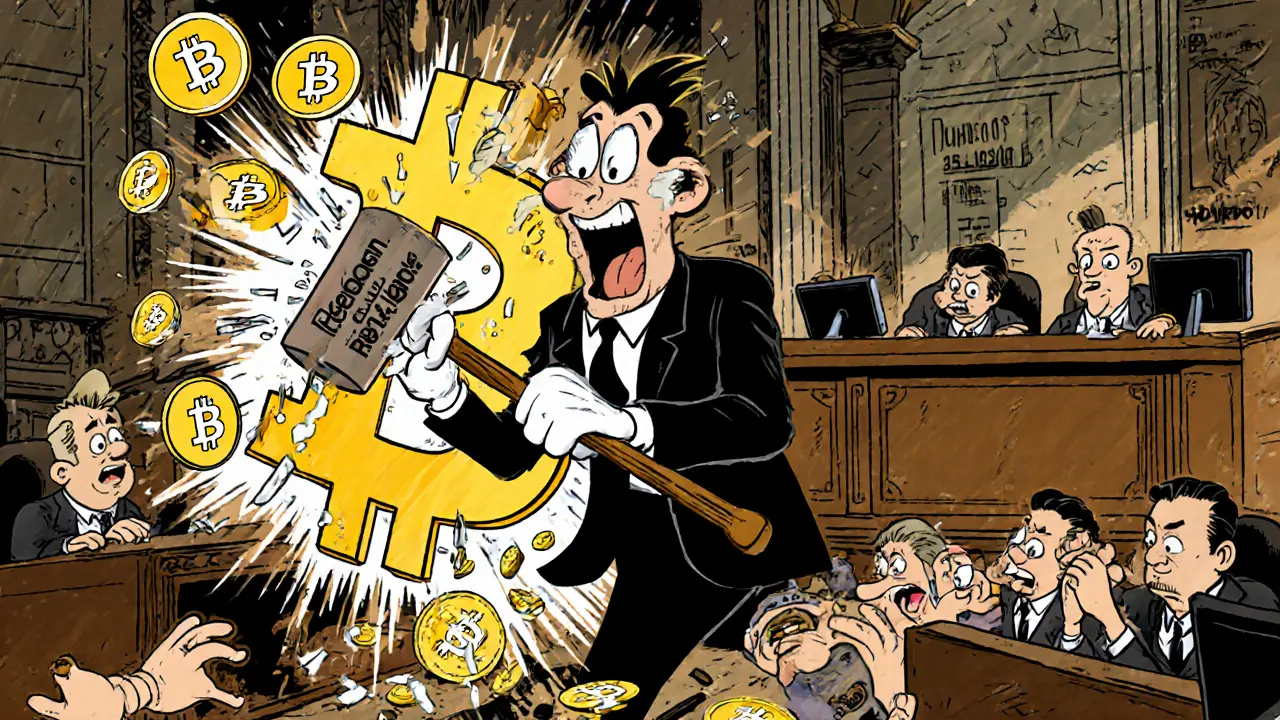Crypto Remittance Cost Calculator
Compare the cost of sending money to Bolivia using traditional remittance services versus cryptocurrency. Based on Bolivia's experience, traditional services charge 15-20% fees while crypto can save you money.
Send Money to Bolivia
Results
Bolivia was the first country in the world to ban Bitcoin outright
In May 2014, Bolivia’s Central Bank issued Resolution No. 24-14-001 - a simple, blunt order that made it illegal to use Bitcoin or any other cryptocurrency. No warnings. No grace period. Just a flat-out ban. This wasn’t a rumor or a draft law. It was official. And it made Bolivia the first country to completely outlaw digital currencies, years before China cracked down on exchanges or Russia considered similar steps.
The resolution didn’t just target Bitcoin. It named other coins too - Namecoin, Peercoin, Quark, Primecoin, Feathercoin - all equally forbidden. The reason? To protect the boliviano, Bolivia’s national currency. The Central Bank claimed these digital assets were uncontrolled, risky, and could cause people to lose their money. They said only the government could issue money, and nothing else was allowed.
How the ban actually worked in practice
The ban wasn’t just a statement. It came with real enforcement rules. Banks couldn’t process any transactions involving Bitcoin. Businesses couldn’t list prices in crypto. Even accepting Bitcoin as payment for goods or services became a legal violation. Financial institutions had to install monitoring systems to catch any crypto activity - and report anything over 5,000 BOB (about $725 at the time) to regulators.
Smaller banks struggled. Some took up to nine months just to set up the systems needed to comply. And even then, they got it wrong a lot. Over 60% of banks reported false positives - legitimate international transfers flagged as crypto activity. The system was clunky, expensive, and full of errors.
But the biggest problem? It didn’t stop people.
People didn’t stop using crypto - they just went underground
While the government said crypto was illegal, Bolivians kept using it. Not in banks. Not in stores. But through peer-to-peer platforms like LocalBitcoins and Paxful. Reddit communities like r/CryptoBolivia grew to over 12,000 members by 2025. People traded Bitcoin for cash in parks, coffee shops, and even bus stations.
A 2021 survey found that 68% of Bolivians using crypto did so through informal channels. Nearly half made at least one crypto transaction every month. Why? Because the boliviano was losing value fast. Inflation hit 5.2% in 2023. People needed a way to protect their savings. Bitcoin, and especially USDT (a stablecoin pegged to the U.S. dollar), became a lifeline.
One Reddit user from La Paz summed it up: “I’ve been using USDT to protect my savings from boliviano depreciation since 2019. The ban doesn’t stop us, it just makes everything more expensive and risky.”
But the risks were real. Fraud cases rose. The Financial Intelligence Unit recorded 147 crypto-related fraud incidents between 2018 and 2023 - totaling over $2.3 million. But experts believe the real number was much higher. Most victims didn’t report it because they were breaking the law just by using crypto.

Why Bolivia’s ban stood out globally
Other countries were nervous about crypto in 2014. China talked about banning exchanges. Thailand warned investors. Russia drafted laws. But none of them followed through with a total ban like Bolivia did.
Japan licensed exchanges. The U.S. treated crypto as property. Even El Salvador - which later made Bitcoin legal tender - didn’t ban it. Bolivia was the only country that said: No crypto. Period.
That made Bolivia an outlier. By 2022, the Blockchain Association of Latin America ranked it as the most restrictive crypto jurisdiction in the region. Only Algeria and Egypt had similar bans.
But the ban had consequences. It didn’t stop capital flight - it made it harder and more expensive. Remittance corridors - where people sent money home from abroad - grew by 19% a year despite the ban. People used crypto to avoid the 15-20% fees charged by Western Union and other traditional services.
Experts were divided - and the IMF eventually agreed
Some officials defended the ban. Dr. Carlos Newland, a former advisor to Bolivia’s Central Bank, wrote in 2015 that emerging economies with unstable currencies couldn’t afford to let digital money compete with the boliviano. He called it a matter of monetary sovereignty.
But others saw it differently. Dr. Rebecca Liao from Stanford called the ban a “protectionist measure” that ignored the real problem: inflation and weak financial infrastructure. The International Monetary Fund (IMF) stayed quiet at first. But by 2020, Alejandro Werner, head of the IMF’s Western Hemisphere Department, said: “Blanket bans on digital assets often prove ineffective and may drive activity underground, reducing regulatory oversight rather than enhancing it.”
Chainalysis confirmed it. Between 2018 and 2022, unregulated P2P crypto transactions in Bolivia jumped 27% above regional averages. The ban didn’t kill crypto - it pushed it into the shadows, where it was harder to track and more dangerous.

The ban ended - and crypto exploded
On June 26, 2024, Bolivia reversed course. The Central Bank lifted the ban. It didn’t make Bitcoin legal tender like El Salvador. But it allowed trading, exchanges, and crypto wallets - as long as they registered with the Financial System Supervisory Authority (ASFI).
The reaction was immediate. Transaction volume jumped 630% in just six months - from $46.5 million in early 2024 to $294 million by mid-2025. By May 2025, total crypto activity hit $430 million. The Meru wallet platform saw a 6,600% surge in users. Most users were men (75%), and most used Binance and USDT.
But the government still won’t let you pay for groceries with Bitcoin. The ban on using crypto as payment remains. The goal? Let people trade and hold - but not spend. It’s a compromise: open the door to innovation, but keep the boliviano as the only official currency.
What’s next for Bolivia’s crypto scene?
Bolivia is now working with El Salvador to learn from their experience - not to copy it, but to avoid their mistakes. The Ministry of Economy predicts crypto transactions will hit $1.2 billion by 2026. Adoption could reach 18% of the population by 2027.
That’s still less than El Salvador’s 23%, but Bolivia’s approach is less risky. No government-backed Bitcoin bonds. No payroll mandates. Just regulated trading. It’s a slow, cautious path - but one that might actually work.
The lesson from Bolivia’s decade-long ban? You can’t stop people from using technology that solves real problems. You can only make it harder, more expensive, and more dangerous. When you lift the ban, the demand doesn’t disappear - it explodes.
Was Bolivia the first country to ban Bitcoin?
Yes. Bolivia’s Central Bank issued Resolution No. 24-14-001 on May 6, 2014, making it the first national government to formally ban Bitcoin and all other cryptocurrencies. No other country had taken such a complete, legally enforceable stance before. China, Russia, and Thailand had discussed restrictions, but none implemented a total ban until years later - if at all.
Why did Bolivia ban Bitcoin in the first place?
The Central Bank claimed Bitcoin threatened the boliviano’s stability and put citizens at risk of losing money to unregulated, volatile assets. They argued that only government-issued currency should be legal tender. The ban was meant to protect monetary sovereignty and prevent capital flight - though critics say it ignored the real issue: high inflation and lack of financial access.
Did the ban actually stop people from using crypto?
No. Despite the ban, an estimated 1.2 million Bolivians (over 10% of the population) used crypto through informal P2P networks by 2023. Platforms like LocalBitcoins and Paxful became popular. People used Bitcoin and USDT to protect savings from inflation and avoid high remittance fees. The ban didn’t kill crypto - it made it riskier and more expensive.
What changed in 2024?
On June 26, 2024, Bolivia officially lifted its crypto ban. The Central Bank now allows trading and holding of digital assets, but only through registered Virtual Asset Service Providers (VASPs). These platforms must follow strict anti-money laundering rules and report transactions daily. However, using crypto to pay for goods or services is still illegal - the boliviano remains the only legal tender for payments.
Is Bitcoin legal in Bolivia today?
Yes - but with limits. You can buy, sell, and hold Bitcoin and other cryptocurrencies legally through registered exchanges like Binance. You can even use them to send money across borders. But you cannot use Bitcoin to pay for groceries, rent, or services. The government still prohibits crypto as a payment method to protect the boliviano.
How has crypto adoption changed since the ban was lifted?
Crypto activity surged after the ban ended. From January to June 2025, transaction volume jumped from $46.5 million to $294 million. By May 2025, total transactions reached $430 million. Wallet platforms like Meru saw a 6,600% increase in users. Most users are individuals using USDT to hedge against inflation. Business use remains low - only 3% of companies report any crypto exposure.

I think Bolivia's move was less about controlling crypto and more about protecting people who didn't have access to real financial education. The ban was harsh, but it forced people to think before they jumped in. Now that it's lifted, hopefully the education follows.
Let us not forget that the boliviano’s instability was the root cause, not some grand conspiracy by Bitcoin enthusiasts. The Central Bank’s decision was a textbook case of regulatory overreach masquerading as protectionism. The fact that P2P usage surged despite the ban proves one thing: when people need a tool, they will find it-regardless of legal fiction. The state cannot legislate away human ingenuity, and yet, they tried. The result? A black market in finance, complete with fraud, no oversight, and zero accountability. This is not a victory for sovereignty-it’s a failure of imagination.
It’s wild to think that people were trading Bitcoin in bus stations just to avoid 20% remittance fees. I’ve seen my cousin in Bolivia send money home through Western Union-it costs more than a plane ticket sometimes. No wonder crypto took off underground. The ban didn’t stop innovation. It just made it dangerous.
Bolivia banned crypto like it was the devil’s spreadsheet. And yet, people still used it. Classic. The government thought they were protecting the people-but really, they were just making sure the rich stayed rich and the poor stayed broke. Now that it’s legal? Everyone’s suddenly a crypto guru. Funny how that works.
This is what happens when you live in a banana republic and try to outsmart global finance. The Central Bank thought they were the boss of money. But money doesn’t care about borders or bureaucrats. It flows. It always flows. And now? The floodgates are open. They lifted the ban not because they were smart-but because they were scared. Scared of their own people. Scared of the truth. Crypto didn’t break Bolivia. It exposed it.
Honestly? I’m not surprised. The U.S. has been warning about crypto volatility for years. Bolivia just had the guts to say NO. Now they’re backtracking because they realized their citizens were smarter than their central bankers. Honestly, I’m glad we didn’t go full Bolivia. We’ve got regulations, transparency, and oversight. Not some chaotic underground exchange in a La Paz café.
The ban was a logical response to unregulated financial instruments posing systemic risk to a fragile economy. The fact that adoption persisted only confirms the failure of state capacity to provide alternatives. The lifting of the ban is not a triumph of innovation but a capitulation to market forces that the state was never equipped to manage
Bolivia’s story is a quiet lesson for every country clinging to monetary control. Technology doesn’t ask permission. It just shows up. And when people are desperate enough-when inflation eats their savings, when remittances cost a fortune-no law can stop them from finding a better way. The ban didn’t protect the boliviano. It protected the illusion that the state alone can define value.
This is not a coincidence. The IMF’s sudden shift in tone after 2020? Coincidence? I don’t think so. The global elite knew the ban was unsustainable. They were quietly preparing the infrastructure for crypto integration while pretending to oppose it. The lifting of the ban? A controlled rollout. A test case for emerging markets. They didn’t want to stop crypto-they wanted to own it. And now Bolivia is just another node in their surveillance network.
It’s fascinating how the same people who decry inflation as a failure of monetary policy then refuse to allow alternatives that directly mitigate it. Bolivia’s ban was ideological, not practical. The fact that USDT became the de facto savings vehicle says everything: people aren’t chasing speculation-they’re chasing stability.
I knew it. I KNEW IT. The government was watching. Every single P2P trade. Every wallet. Every cash meetup. They were building a database. Now they’ve legalized it so they can tax it. And track it. And control it. Crypto was never about freedom-it was always about the government getting better at catching you. 💀
Oh wow, Bolivia finally got the memo. Took them ten years. Meanwhile, the U.S. is still letting people trade crypto like it’s a carnival game. You know what’s worse than a ban? A ban followed by a half-assed regulatory compromise. Now people can hold crypto but not spend it? That’s not progress. That’s just bureaucratic cowardice.
Bolivia’s journey offers a rare, real-world case study in how policy can both fail and evolve. The initial ban reflected fear. The reversal reflects adaptation. What’s remarkable is that the population didn’t wait for permission-they built their own solutions. That’s the true innovation: not the technology, but the human resilience behind it.
Let’s be real. This was never about protecting the boliviano. It was about protecting the elite’s control over the financial system. The ban was a tool of exclusion. And now, the same elite are the ones running the registered exchanges. The people still lose. The system just got a new coat of paint.
Wait, wait, wait-so they banned it because it was risky, then people used it anyway because it was the only way to save money, then they lifted the ban because it was too popular, but they still won’t let you use it to buy coffee??? This is the most chaotic policy I’ve ever seen. Like, who wrote this? A confused toddler with a thesaurus??
Bolivia ban crypto but people still use it? That what happen when you have no proper banking system. In India also many people use crypto because bank is slow and expensive. USDT is best for remittance. I use it too. No problem. Government should not stop tech. They should learn from it.
I mean… imagine being in Bolivia in 2018. Inflation rising. Your paycheck shrinking. Your family overseas sending money through Western Union and losing 20% just to send $100. And then you find out you can get $100 worth of USDT for $95? No middleman. No paperwork. No waiting. You don’t need a degree in economics to know that’s a no-brainer. The ban wasn’t about money-it was about control. And people? They chose freedom. 🙌
This is exactly what happens when a nation abandons sound monetary policy. The boliviano’s depreciation was predictable. The crypto underground was inevitable. The government’s response was not only ineffective-it was immoral. By criminalizing financial自救, they forced the poor into riskier, unregulated spaces. This is not sovereignty. It is negligence dressed as authority.
The real irony? Bolivia banned crypto because it was decentralized. But now they’ve created a new kind of control: registered VASPs that report everything to ASFI. So instead of anonymous peer-to-peer, you’ve got government-approved crypto kiosks. That’s not freedom. That’s just a new version of the same cage.
Why are people acting like this is some great breakthrough? The ban was stupid. The lifting is just damage control. The real problem is Bolivia still has no real financial infrastructure. Crypto is not a solution-it’s a symptom. Fix the economy. Stop treating symptoms with regulation.
I think this is one of the most human stories I’ve read about crypto. It’s not about tech or speculation. It’s about people doing what they have to do to survive. The ban tried to erase that. The lifting didn’t celebrate it-it just acknowledged it. And maybe that’s the first step toward real change.
I wonder if the next step is allowing crypto for small business payments. Right now, it’s just trading and holding. But if people are already using it informally to pay for services, why not formalize it with limits? Maybe a $50 cap per transaction? It’d be a gentle transition.
That’s exactly the kind of incremental, pragmatic approach that could work. Not a full El Salvador-style mandate, but a pilot program-allowing micro-payments in USDT for street vendors, ride-share drivers, or small clinics. It would build trust without destabilizing the boliviano. The government’s hesitation makes sense-but it’s also holding back real economic inclusion.